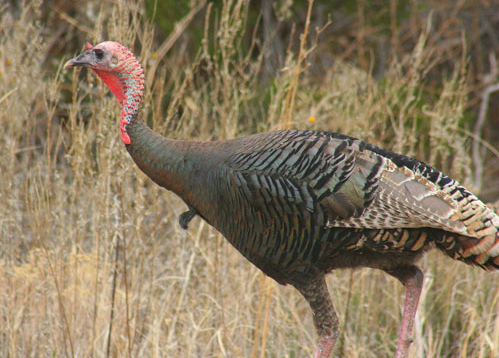Two years after the worst spring turkey hunting season in Texas in three decades, things are looking up for gobbler fanatics.
The spring Rio Grande turkey season is now open across the state, and by all accounts 2013 has shaped up as a rebound year for production, carryover and harvest estimates.
There certainly would have been a large carryover of birds into last spring based on low overall harvest rates that have been common recently, but last season and certainly the previous season saw some of the most awful turkey hunting conditions imaginable amid severe drought that scorched the landscape and left virtually no room for any significant hatch. Texas hunters only harvested about 16,000 birds in 2010 and roughly 12,000 the next year, according to TPWD figures, the lowest figure in three decades. Many well-known gobbler hunters I talked to in previous springs have had little to no success seeing many birds, much less luring an amorous longbeard into scattergun range.
The impacts of prolonged drought on ground-nesting birds such as turkeys and quail can be severe in many cases, and in some instances the overall hatch across the state seemingly can be wiped out, which is basically what happened to a large degree a couple of years ago. The biggest hindrance to nesting in exceedingly dry years is that suitable habitat simply doesn’t exist and birds that attempt to lay eggs aren’t successful for a variety of factors, including predation. Some hens won’t even attempt to lay eggs in really dry years due to lack of nutrients.
Turkey hunting already is tough enough, but when the elements combine to stack the deck against hunters it can seem downright impossible, especially for those only able to hunt a weekend or two at most.
Gobblers, like hens, also tend to go into survival mode in seasons such as 2011, and when they don’t want to talk turkey it leads to frustration for hunters. When hens show little interest in mating, gobblers also typically will shut down their pursuits in favor of food, which makes them much less susceptible to hunters producing their best hen call imitations.
While birds seemingly showed a lack of interest last season, the long-term trend in turkey hunter participation also has waned. The mid-1990s saw the highest participation and harvests during the spring season since the Texas Parks and Wildlife Department began actively tracking hunter participation and success. In 1994, TPWD tallied about 94,000 hunters who shot about 33,000 turkeys. Fast forward 15 years and the numbers declined to about 53,000 and 23,000, respectively. The 10-year harvest average sits at roughly 23,000.
While the overall level of enthusiasm for spring turkey hunters has waned, based on TPWD data, there is a silver lining that should shine brightly for at least the next couple of spring seasons. One good year of improved or even average production will carry a turkey population that has numbered at more than a half-million birds for at least two, if not three future seasons. The older birds hunters are seeking will have come from hatches of 2009 or 2010, while there should be a surplus of younger jakes that will have survived from the most recent hatch.
Hunters this year are allowed to harvest bearded hens in counties with a four-bird bag limit. Hens easily are distinguishable from gobblers based on their head coloration and calling characteristics, but in low light it could be easy to mistake a bearded hen for a tom. The National Wild Turkey Federation estimates that between 10 percent and 20 percent of hens have beards.
If you’re looking for a hot spot that doesn’t get a lot of pressure, look no further than the Rolling Plains and eastern Panhandle. Those areas don’t typically don’t get much credit for being turkey hotbeds, but the gobbler outlook for the next month is as strong as it has been in a number of seasons. There aren’t the same densities of birds as in the Hill Country and South Texas, but there certainly should be enough to entice seasoned and novice hunters alike as temperatures warm.
State biologists have said there is nothing in particular to which the turkey hunting decline can be attributed, but it’s certain that the future of the pursuit rests with youth hunters. Turkey hunting can be tough for young hunters because there typically are periods of boredom sprinkled with short bursts of activity and success rests with staying calm and motionless. However, there’s no better way to introduce a youngster to the outdoors than by toting them along on a spring hunt, especially in a season such as this where you should be able to locate birds.
There are youth-only seasons set May 4-5 in the South Zone and May 18-19 in northern counties, but there’s never a better time than the present to pass on the pursuit.


















